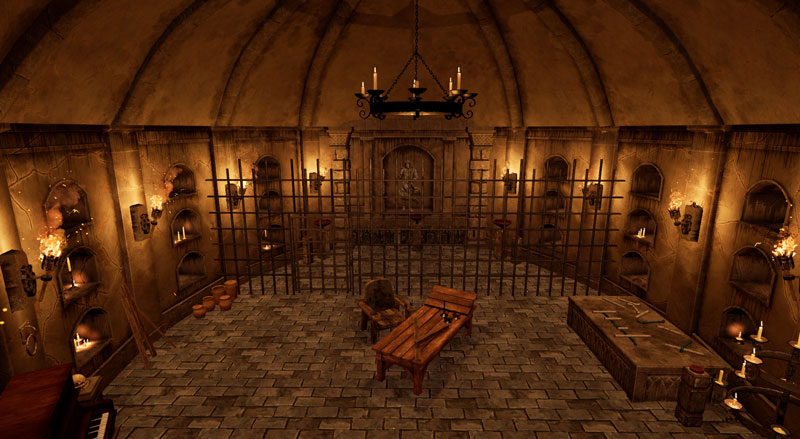by Stylianos Mystakidis (University of Patras)
Spatial computing, extended reality (XR) and the Metaverse are emerging technologies with the potential to transform education and training. However, technology-use alone in education without suitable pedagogical strategies and methods cannot guarantee effective learning experiences. Meaningful gamification in the form of escape room games is one viable option to increase sustainable engagement and instil passion in learning.
Spatial computing, XR and the Metaverse are emerging technologies with the potential to transform education and training beyond the capabilities of current learning systems since they enable the creation of powerful, detailed, episodic memories. The human brain treats experiences in 3D virtual immersive spaces in the same fashion as in the physical world. Therefore, it is possible to realistically replicate spaces, objects, and practices in virtual environments.
However, technology-use alone cannot guarantee effective learning experiences. In the era of 3D virtual words or Metaverse 1.0, the first inclination of educational institutions was to build replicas of the physical campuses, schools, auditoria, and classrooms [L1]. Similar moves are observed in the current-iteration Metaverse 2.0 [L2]. While this move is understandable as an exploratory step and has merit in several contexts such as online distance education, the effectiveness of such environments is questionable; is a lecture more effective in a physical auditorium, online via videoconferencing, or in a virtual space?
Conventional learning in XR starts with the observation of 3D visualisations and the manipulation of 3D objects and models. While these methods can be valuable, several efforts have been undertaken to identify taxonomies of effective instructional design methods in AR [L3] and VR [L4]. Deep, long-lasting and transformative learning usually involves three elements: cognitive involvement, the generation of emotions and some form of social interaction [L5].
Gamification is one method that can address the aforementioned cognitive, affective and social domains of learning by integrating playful and gameful elements into the training materials, environment or process [1]. A superficial, structural gamification approach adds a layer of game mechanics such as points, badges and leaderboards on top of learning providing extrinsic incentives and rewards. A more sophisticated and meaningful gamification strategy aims at activating the intrinsic motivation of learners. It uses sophisticated game dynamics and techniques such as narratives, freedom of choice, discovery and reflection to immerse learners to create curiosity and interest to explore and engage with the game mechanics. Notable examples of story-driven gamified XR learning experiences are escape or breakout room games in virtual reality [2] and augmented reality [3]. Escape rooms are games that engage players in adventurous missions, usually to exit from one or more confined spaces. While these live-action games were conceived as a form of entertainment, they can be used to serve a serious, educational purpose.
The “Lost in the Echoes” immersive virtual reality serious escape room game is an example from the realm of a science education, namely physics [2]. Users are briefed about their mission and enter a fictional dungeon ( 1). There they engage with sounds, music and acoustics executing various tasks that generate sounds and learning experientially about these concepts as they progress through several levels. These activities realistically simulate learning activities that are being undertaken during a learning programme on the origin of sound and music in a physical science museum. This game can be played in immersive virtual reality headset such as Oculus Quest 3.

Figure 1: Aerial view of one virtual environment of the “Lost in the Echoes” serious VR escape room game.
In physical training settings, clues and evidence can be arranged as an invisible digital layer in objects and specific locations that can be visualised and accessed through mobile devices, smart glasses and mixed reality headsets such as Apple Vision Pro. For example, in the augmented reality serious escape room game “LockED in ShakespeARe’s Globe Theatre”, a virtual field trip to the famous theatre turns into a thrilling drama when the spirit of the famous author traps learners and challenges their cultural knowledge, communication and cooperation skills [3].
XR escape room games are a useful format that can be applied creatively across diverse fields such as health (e.g. medicine, safety), STEM (e.g. chemistry, mathematics, engineering, programming) and HASS domains (e.g. humanities, language, arts, social sciences). Preliminary results from various experiments [L6] revealed that these learning experiences enable deeper comprehension and improved retention. At the same time, trainers and teachers approved this method and are willing to use them in their courses [L7]. Augmented reality overlays in serious escape rooms can animate any physical setting alive and implement multiple scenarios. A virtual reality escape game can be very effective in distance online educational settings. It provides a relatively short experience around a field, theme, topic, concepts or procedures. In contrast to simple simulations, it creates a fictional, virtual narrative world where learners are the protagonists who are challenged to execute a mission which in relevant and directly linked to the intended learning outcomes. Although pre-designed escape room games can be used as assignments or live classroom activities, in line with the taxonomy of instructional design methods in AR [L3] escape rooms can also be designed by learners as project deliverables to demonstrate their comprehension and creativity.
Links:
[L1] https://www.govtech.com/education/universities-use-second-life-to-teach.html
[L2] https://edtechmagazine.com/higher/what-is-a-metaversity-perfcon
[L3] https://doi.org/10.1007/s10639-021-10682-1
[L4] https://doi.org/10.1016/j.compedu.2022.104701
[L5] https://doi.org/10.3390/encyclopedia1030075
[L6] https://doi.org/10.1109/IISA.2019.8900673
[L7] https://doi.org/10.3390/info13030136
References:
[1] A. Christopoulos, and S. Mystakidis, “Gamification in education,” Encyclopedia, vol 3, no. 4, pp. 1223–1243, 2023. https://doi.org/10.3390/encyclopedia3040089
[2] G. Vontzalidis, et al., “Spatial audio cues in an immersive virtual reality STEM escape room game: a comparative study,” 10th Int. Conf. of the Immersive Learning Research Network (ILRN 2024), 2024.
[3] A. Voreopoulou, S. Mystakidis, and A. Tsinakos, “Augmented reality escape classroom game for deep and meaningful English language learning,” Computers, vol. 13, no. 1, p. 24, 2024. https://doi.org/10.3390/computers13010024
Please contact:
Stylianos Mystakidis, University of Patras, Greece










